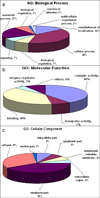An analysis of the transcriptome of Teladorsagia circumcincta: its biological and biotechnological implications
- PMID: 23282110
- PMCID: PMC3521389
- DOI: 10.1186/1471-2164-13-S7-S10
An analysis of the transcriptome of Teladorsagia circumcincta: its biological and biotechnological implications
Abstract
Background: Teladorsagia circumcincta (order Strongylida) is an economically important parasitic nematode of small ruminants (including sheep and goats) in temperate climatic regions of the world. Improved insights into the molecular biology of this parasite could underpin alternative methods required to control this and related parasites, in order to circumvent major problems associated with anthelmintic resistance. The aims of the present study were to define the transcriptome of the adult stage of T. circumcincta and to infer the main pathways linked to molecules known to be expressed in this nematode. Since sheep develop acquired immunity against T. circumcincta, there is some potential for the development of a vaccine against this parasite. Hence, we infer excretory/secretory molecules for T. circumcincta as possible immunogens and vaccine candidates.
Results: A total of 407,357 ESTs were assembled yielding 39,852 putative gene sequences. Conceptual translation predicted 24,013 proteins, which were then subjected to detailed annotation which included pathway mapping of predicted proteins (including 112 excreted/secreted [ES] and 226 transmembrane peptides), domain analysis and GO annotation was carried out using InterProScan along with BLAST2GO. Further analysis was carried out for secretory signal peptides using SignalP and non-classical sec pathway using SecretomeP tools. For ES proteins, key pathways, including Fc epsilon RI, T cell receptor, and chemokine signalling as well as leukocyte transendothelial migration were inferred to be linked to immune responses, along with other pathways related to neurodegenerative diseases and infectious diseases, which warrant detailed future studies. KAAS could identify new and updated pathways like phagosome and protein processing in endoplasmic reticulum. Domain analysis for the assembled dataset revealed families of serine, cysteine and proteinase inhibitors which might represent targets for parasite intervention. InterProScan could identify GO terms pertaining to the extracellular region. Some of the important domain families identified included the SCP-like extracellular proteins which belong to the pathogenesis-related proteins (PRPs) superfamily along with C-type lectin, saposin-like proteins. The 'extracellular region' that corresponds to allergen V5/Tpx-1 related, considered important in parasite-host interactions, was also identified. Six cysteine motif (SXC1) proteins, transthyretin proteins, C-type lectins, activation-associated secreted proteins (ASPs), which could represent potential candidates for developing novel anthelmintics or vaccines were few other important findings. Of these, SXC1, protein kinase domain-containing protein, trypsin family protein, trypsin-like protease family member (TRY-1), putative major allergen and putative lipid binding protein were identified which have not been reported in the published T. circumcincta proteomics analysis. Detailed analysis of 6,058 raw EST sequences from dbEST revealed 315 putatively secreted proteins. Amongst them, C-type single domain activation associated secreted protein ASP3 precursor, activation-associated secreted proteins (ASP-like protein), cathepsin B-like cysteine protease, cathepsin L cysteine protease, cysteine protease, TransThyretin-Related and Venom-Allergen-like proteins were the key findings.
Conclusions: We have annotated a large dataset ESTs of T. circumcincta and undertaken detailed comparative bioinformatics analyses. The results provide a comprehensive insight into the molecular biology of this parasite and disease manifestation which provides potential focal point for future research. We identified a number of pathways responsible for immune response. This type of large-scale computational scanning could be coupled with proteomic and metabolomic studies of this parasite leading to novel therapeutic intervention and disease control strategies. We have also successfully affirmed the use of bioinformatics tools, for the study of ESTs, which could now serve as a benchmark for the development of new computational EST analysis pipelines.
Figures



Similar articles
-
Characterisation of a niche-specific excretory-secretory peroxiredoxin from the parasitic nematode Teladorsagia circumcincta.Parasit Vectors. 2019 Jul 10;12(1):339. doi: 10.1186/s13071-019-3593-6. Parasit Vectors. 2019. PMID: 31292008 Free PMC article.
-
A preliminary proteomic characterisation of extracellular vesicles released by the ovine parasitic nematode, Teladorsagia circumcincta.Vet Parasitol. 2016 May 15;221:84-92. doi: 10.1016/j.vetpar.2016.03.008. Epub 2016 Mar 17. Vet Parasitol. 2016. PMID: 27084478 Free PMC article.
-
The transcriptome of Echinostoma caproni adults: further characterization of the secretome and identification of new potential drug targets.J Proteomics. 2013 Aug 26;89:202-14. doi: 10.1016/j.jprot.2013.06.017. Epub 2013 Jun 21. J Proteomics. 2013. PMID: 23796492
-
The barber's pole worm CAP protein superfamily--A basis for fundamental discovery and biotechnology advances.Biotechnol Adv. 2015 Dec;33(8):1744-54. doi: 10.1016/j.biotechadv.2015.07.003. Epub 2015 Jul 31. Biotechnol Adv. 2015. PMID: 26239368 Review.
-
Insights into the immuno-molecular biology of Angiostrongylus vasorum through transcriptomics--prospects for new interventions.Biotechnol Adv. 2013 Dec;31(8):1486-500. doi: 10.1016/j.biotechadv.2013.07.006. Epub 2013 Jul 27. Biotechnol Adv. 2013. PMID: 23895945 Review.
Cited by
-
Transcriptome profiles of the protoscoleces of Echinococcus granulosus reveal that excretory-secretory products are essential to metabolic adaptation.PLoS Negl Trop Dis. 2014 Dec 11;8(12):e3392. doi: 10.1371/journal.pntd.0003392. eCollection 2014 Dec. PLoS Negl Trop Dis. 2014. PMID: 25500817 Free PMC article.
-
Perusal of parasitic nematode 'omics in the post-genomic era.Mol Biochem Parasitol. 2017 Jul;215:11-22. doi: 10.1016/j.molbiopara.2016.11.003. Epub 2016 Nov 22. Mol Biochem Parasitol. 2017. PMID: 27887974 Free PMC article. Review.
-
Advances in translational bioinformatics and population genomics in the Asia-Pacific.BMC Genomics. 2012;13 Suppl 7(Suppl 7):S1. doi: 10.1186/1471-2164-13-S7-S1. Epub 2012 Dec 13. BMC Genomics. 2012. PMID: 23282089 Free PMC article.
-
Niche-specific gene expression in a parasitic nematode; increased expression of immunomodulators in Teladorsagia circumcincta larvae derived from host mucosa.Sci Rep. 2017 Aug 3;7(1):7214. doi: 10.1038/s41598-017-07092-0. Sci Rep. 2017. PMID: 28775251 Free PMC article.
-
The role of 'omics' in the quest to eliminate human filariasis.PLoS Negl Trop Dis. 2017 Apr 20;11(4):e0005464. doi: 10.1371/journal.pntd.0005464. eCollection 2017 Apr. PLoS Negl Trop Dis. 2017. PMID: 28426656 Free PMC article. Review. No abstract available.
References
-
- Nisbet AJ, Smith SK, Armstrong S, Meikle LI, Wildblood LA, Beynon RJ, Matthews JB. Teladorsagia circumcincta: activation-associated secreted proteins in excretory/secretory products of fourth stage larvae are targets of early IgA responses in infected sheep. Exp Parasitol. 2010;125(4):329–337. doi: 10.1016/j.exppara.2010.02.014. - DOI - PubMed
Publication types
MeSH terms
Substances
Grants and funding
LinkOut - more resources
Full Text Sources
Research Materials

